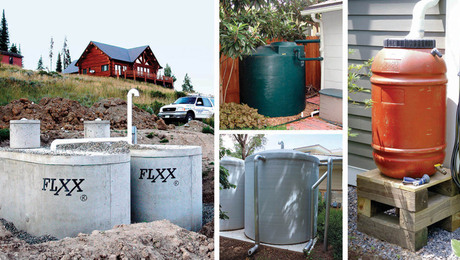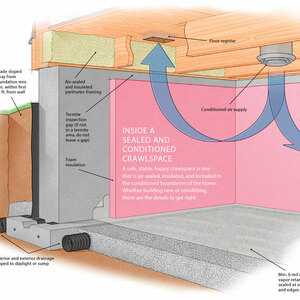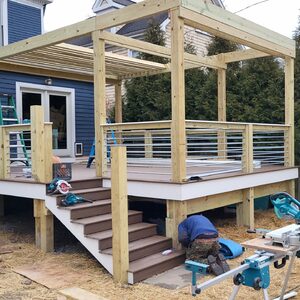Hi,
I have a 3 story colonial house located in central Maryland. I feel that I was just reciently taken by a large licensed and insured waterproofing company. My initial complaint was water entering my basement when my exterior floor drain in the exterior stairwell leading to the basement would get clogged with leaves and the rain water would enter the basement through the basement door.
We never in 22 years have had any signs of water entering our basement with the exception water entering through the basement door when the exterior drain was clogged with leaves. Somehow my husband and I got talked into installing a French drain around the perimeter of our basement leading to a sump pump. Three days after the installation of the French drain and $8000.00 later we had our first rain storm and we lost power. We had to bail water out of our sump pit and carry it outside. It turns out that the water in the sump pit was not from the new french drain. The water proofing company abandonded the exterior drain that was tied into the city sewer and directed the drain to the sump pump. We have gone from a dry basement to a basement that fills the sump pit with exterior stairwell water and have to rely on a sump pump to remove the water from the house. This exterior drain never clogged intirnally in the 22 years we have owned the house. It only clogged when we neglected to clear leaves from the surface of the small drain cover.
Prior to the installation of the French drain our basement was finished with 1970 style 1/8″ paneling installed overtop of 3/4″ furring strips nailed to the cinder block wall with no insulation. The waterproofing company cut the bottom 8 to 10 inches of the paneling and furring strips off to install a weep barrier that extends into the french drain. They said that they could install a tall base trim to cover this cut out section of paneling. This does not sound like an actractive option. I am done doing business with this waterproofing company and do not like this option. I also really do not like this outdated paneling.
Now to the insulation questions. I no longer want the paneling in my basement or the staple up tile ceiling. I got a couple of estimates to install drywall. The first contractor wants to remove the paneling and install the new drywall over the existing furring strips. The second contractor wants to install the drywall overtop of the paneling and says that the paneling does not need to be removed and insulation is not necessary since the bottom half of the exterior wall is below grade. A friend refered me to a third contractor and he thought that both of the other contractors were not approching this in the correct way. He told me we should remove the panneling and furring strips. We should frame out the walls with 2 x 4’s, install insulation with a vapor barrier and then install new drywall. He informed me that this approach would be more expensive but the payoff whould be worth the extra cost.
This contractor told us that insulating the exterior walls and rim joist will help reduce our energy consumption and increase the comfort level of the basement. He made a point to state that the extra cost of the insulation will reduce energy consumption but will not cut my energy bill in half and it will take many years for the extra cost of the insulation to pay for itself. He stated all finished basements should be insulated and air sealed and this process will create a more comfortable living space without air drafts and help keep the basement temperature closer to the two floors above. He also mentioned that the framed walls will make it easier to install new electrical plugs, switches and lighting.
After being taken by the waterproofing company for a service that I did not need in the first place, I need a little help from some professional. We plan to make the basement the new family room. Should I have my basement framed and insulated even though it has never been insulated in 56 years? Is insulating my basement worth the extra cost? Is there anything wrong with drywalling overtop of the existing paneling?
I am looking forward to any helpfull information.
Thanks
Joanie


















Replies
This third guy has the right general approach and sounds honest due to the way he explains things, iMO
But I see no reason to remove the furring if it is well attached. Instead of studs and fibreglass insulation, I would apply1" or 1-1/2" blue or pink foam panels over the furring and then finish surface over that. This will be easier and will give equivalent insulation that is not damaged by future water or condensation.
Sorry for your troubles. Keep this site in mind for future needs as well.
Basement Insulation and Framing
I called the third contractor and told him about your sugestion to install ridgid insulation overtop of the existing furring strips. He said that this is a good approach in many situations, however in my situation where the finished paneling walls are very wavy, the new insulation and drywall would telegraph the imperfectons to the new finished drywall. That seems reasonable. What do you think?
I also mentioned that you said that the insulation overtop of the furring strips would help protect against future water and condensation. He replied that the new frame wall will be spaced 3/4" off of the exterior block wall and the new framing and insulation would not be in contact with the block wall, therefore it should not get wet if there was any future water or condensation problems. This seams to make sense to me. Does this sound right?
The contractor also said he would provide a low cost option that could help protect against future water infiltration. He said that while the walls were open he could scrape and clean the walls and apply a masonry sealer overtop of the cinder block wall. I think he said it was a product called drylock. If it is not too expensive is this a good option?
The contractor gave me a discription of how he would insulate the basement. He said he would start by caulking all seams, penetrations and joints to stop air infiltration. The walls would get a R thirteen insulation on the walls and the rim joist would get a r thirty insulation. All insulation will have a craft face vapor barrier. I am not to sure I completely understand the "R" rating system except that I understand the higher the "R" number the more effective the insulation is. He said he would give me an option to spray foam the rim joist and said this cost extra, however it is a superior alternative to fiberglass insulation to prevent air infiltration.
I am looking forward to your feed back.
Thanks
Joanie
The original contractor probably disconnected the exterior drain from the (sanitary?) sewer because such connections are now illegal in most parts of the country. (However, if it was a storm sewer then the connection should have been left in place.)
You can purchase a battery-powered supplemental sump pump.
It is correct that while insulating will not save a substantial amount of money (will not "pay for itself"), it will make the area MUCH more comfortable, if properly done.
However, don't do anything until you're confident that the water problem has been solved.
Basement Insulation and Exterior Drain
The contract with the waterproofing contractor stated that they were going to replace the existing 3 inch round drain with a 8 inch by 8 inch square drain with a larger surface to help protect against leaves clogging the drain. This drain was to be tied into the existing drain line since there was never a problem with the internal drain line. The owner of the company conceded to the fact that they did not do what was in the contract and the employees in the field made the decision to tie the drain into the french drain and that was a mistake.
They did come back and tied the exterior drain back into the existing drain line, however they put in a secondary drain that still flows to the sump pump by letting the exterior drain water enter the interior french drain and travel to the sump pump (I am not sure why). We let them talk us into a battery back up for the sump pump for an additional $800.00 to protect against power outages.
I called my brother inlaw who is a licensed plumber in our County to see if it was legal to have exterior storm water enter the city sewer system. He said that you can not add additional rain water to the city sewer system, however if the exterior drain system exists you can keep this drain system even if you make a larger drain opening to make it less likely to clog.
After the waterproofing company came back and completed the work to reroute the drain into the existing sewer line (per contract) the contractor that wants to insulate the basement stated that the battery back up system is a fairly good system but there was possibily a better option. Battery back up systems can last for only hours to maybe a day or two depending on the efficency of the sump pump, how often the sump pump has to cycle and a few other reasons that I can not remember. He stated that since your house sits on top of a hill it would have been easy to install a gravity drain above the sump pump discharge that would that would lead to daylight and if the sump pump ever failed or there was a power outage the water would find relief by draining to the exterior of the house by means of gravity. he said that this is as close to fail safe as possible as long as the exit path of the drain was kept clear of debris, snow and screened from insect and rodent infiltration. Does this sound like a good plan?
Do you have any additional information that I should be aware of for insulating my basement?
Thanks
Joanie
A gravity drain is always better than a sump pump, where the option is reasonably available. ("Reasonably" means without tearing up too much stuff, where there's a reasonable exit point (not in the middle of the front yard, etc), and without being so long and convoluted that it's likely to clog.) In your case, using gravity as a backup to the sump pump sounds like a good idea, so long as you don't forget it's there and fail to keep it clear. The one downside of having gravity as the backup vs primary is that it won't be flushed clear regularly.
(In many parts of the country you'd be required to disconnect your exterior drain and sump pump from the sewer, even though the connection's been "grandfathered". Around here they came around looking for such connections about 10 years ago -- legally the residents were required to allow the inspectors to enter every house to check.)
In So Fast Panels
I am going to be using these in my basement. Seems like a great solution to me anyone have experience with them?
http://www.insofast.com/
E
Why are we suddenly getting even more spam than usual?
Easy there, it actually related to the topic at hand!
It soinds like your third contractor is on the right path, but here's my thoughts.
If you plan on using the basement on a regular basis, you should insulate it. It will help regulate the temps down there.
But i wouldn't use fiberglass isulation in a basement. If you do get water again, the fiberglass will absorb it, and wick it up the walls.
For your job, budget permitting, I'd strip the old paneling and firring strips to the foundation, glue 2" rigid foam to the foundation walls, tape the seams, and frame in front of that. Basements are one area I like to use metal studs, because of the usual humidity problems. Mold won't grow on metal, while it could grow on wood. I also like to use moisture resisitant drywall for the same reason.
Andy Engel wrote an excellent article on finishing basements a number of years ago for Fine Homebuilding. It'd be worth tracking it down
Finishing Basements
I would love to read informative articles on finishing basements. I am new to this form. How do I track down this article?
The article was in the March 2005 issue of Fine Homebuilding.
I have the magazine, but I think if you get an on-line membership you can search through back issues.
Since I've been subscribing for decades, I never joined on-line.
Like Shep said:
The easiest way is to get an online membership. I think it is free for the first thirty days.
I gave up my hardcopy subscription several years ago, and now hav eonly the online one. It is lots easier for me to search online for articles I want, than to deal with the space, and effort required to keep the hard copies cataloged, or even gathered together in one place.